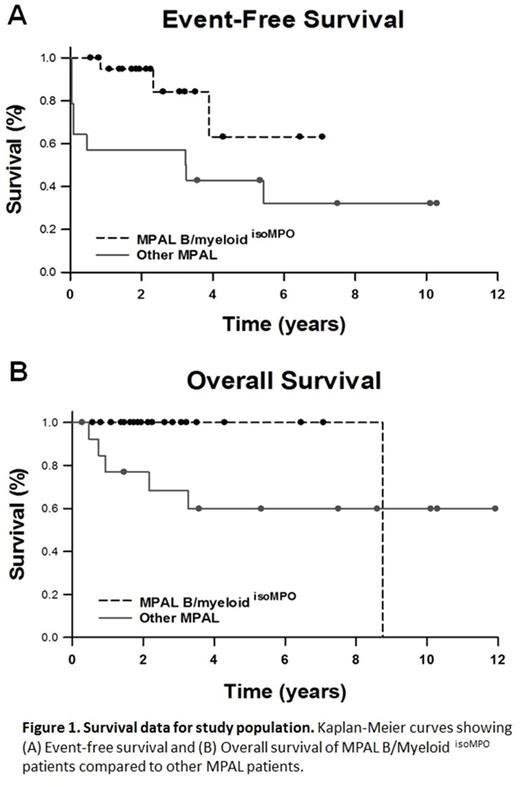Abstract
Background: Mixed phenotype acute leukemia (MPAL) represents a heterogeneous group of leukemias accounting for 2-5% of all newly diagnosed acute leukemias. Diagnostic criteria for mixed phenotype MPAL have evolved over time, with the World Health Organization (WHO) 2016 criteria now being recognized as the more definitive standard. According to WHO classification, isolated expression of myeloperoxidase (MPO) allows for myeloid lineage assignment in patients with an otherwise typical B-acute lymphoblastic leukemia (B-ALL) phenotype, thus meeting criteria for MPAL B/myeloid. Our goal was to determine if there were differences in treatment and survival between this group of patients, classified as MPAL B/myeloid isoMPO, and other MPAL patients.
Methods: Data was obtained through a retrospective chart review of pediatric MPAL patients treated between 2001 and 2016 at Children's Healthcare of Atlanta. Cases were identified through our institutional tumor registry and pathology department flow cytometry database. Cases were eligible if the patients were between ages of 1 and 21 years at diagnosis and the leukemia met the WHO 2016 MPAL criteria. We excluded therapy related cases, non-myeloid cases (rare B/T subtype), and cases with a t(9;22) translocation. Data were extracted from clinical records for patient, disease and treatment related variables. All flow cytometry reports were reviewed by study hematopathologists. Cases were divided into two groups - MPAL B/Myeloid isoMPO and other MPAL cases. MPAL B/myeloid cases were classified as MPAL B/Myeloid isoMPO if there was a single B-lineage blast population expressing MPO as the only WHO MPAL myeloid marker. An event was defined as treatment failure requiring therapy change prior to end of induction (EOI), induction failure, induction death, remission death, or relapse. Event-free survival (EFS) and overall survival (OS) were calculated using Kaplan-Meier survival curves. Groups were compared using the log rank test. Chi-squared test was used for sampling distribution analyses.
Results: Of the 35 MPAL cases included in our study, 21 (60%) met criteria for MPAL B/myeloid isoMPO. 20 of these patients were treated with ALL chemotherapy alone. One patient underwent bone marrow transplantation (BMT) due to a low DNA index. None of these patients were switched to myeloid therapy during their treatment course. The other 14 MPAL cases consisted of 5 MPAL B/myeloid (non-isolated MPO), 7 MPAL T/myeloid and 2 MPAL patients with t(v;11q23); MLL rearranged. Of these 14 cases, 10 were treated at least in part with myeloid chemotherapy and 7 proceeded to BMT. 6 of 10 patients in this group who started with ALL induction were switched over to AML therapy, with 3 being changed prior to EOI due to treatment failure. Despite these treatment differences, those with MPAL B/myeloid isoMPO had better outcomes. 3-year EFS was significantly higher at 84% for the MPAL B/myeloid isoMPO group compared to 57% in the other MPAL group (p=0.027 log rank test, Fig 1A). 3-year overall survival was 100% and 68%, respectively (p=0.083 log rank test, Fig 1B).
Conclusion: There continues to be no consensus as to how to treat MPAL and the changing definition of MPAL has contributed to the difficulty in treating this rare and heterogeneous disease. While the WHO 2016 criteria have simplified the definition of MPAL, it has created a group of patients as shown here, that may be falsely categorized as MPAL. Our results suggest that MPAL B/myeloid isoMPO patients behave clinically like typical B-ALL patients, and should be treated as such. Consideration should be given to redefining the current MPAL WHO criteria to explicitly exclude these cases.
No relevant conflicts of interest to declare.
Author notes
Asterisk with author names denotes non-ASH members.


This feature is available to Subscribers Only
Sign In or Create an Account Close Modal